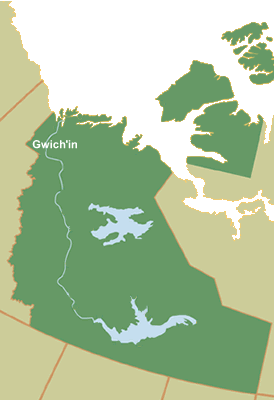 Barbue,
a Gwich'in trading chief, traded at Fort Good Hope on the Deh Cho (Mackenzie
River) during an early period of the northern fur trade. This easternmost group
of Gwich'in (also known as Kutchin, and later Loucheux) first came into contact
with Europeans during Alexander Mackenzie's journey to the Beaufort Sea. The
French traders who arrived soon after referred to them as Squinteyes, or Loucheux.
By the end of the 1800s, they had adopted that very name.
Barbue,
a Gwich'in trading chief, traded at Fort Good Hope on the Deh Cho (Mackenzie
River) during an early period of the northern fur trade. This easternmost group
of Gwich'in (also known as Kutchin, and later Loucheux) first came into contact
with Europeans during Alexander Mackenzie's journey to the Beaufort Sea. The
French traders who arrived soon after referred to them as Squinteyes, or Loucheux.
By the end of the 1800s, they had adopted that very name.
Old Fort Good Hope was established in 1806, at the mouth of the Blue Fish River.
It was relocated soon after however, to a more southern location, opposite the
mouth of the Hare Indian River. The decision was made for two reasons: first,
it shortened the distance of the southern supply route; and second, the Gwich'in
who traded there were not always comfortable coming so close to the land of
the Siglit (Inuvialuit), with whom they sometimes fought.
The Fort was relocated again in 1823, to a spot further north on the Deh Cho.
There, Barbue was noted for the first time by the Hudson's Bay Company as a
trading chief. As such, in 1827 he received "1 coat Shirt, 1 pr Leggins & 1lb
beads." The trade between Barbue and the post was made up primarily of muskrat
and marten. Supplying meat to the Fort was also an important source of income
for Barbue and the Gwich'in. In exchange for their furs and meat, they received
many kinds of ironworks, such as knives and kettles, dry goods such as clothing
and blankets, firearms, ammunition, and glass beads. The Gwich'in who traded
at Fort Good Hope were especially fond of blue glass beads, which they used
to adorn clothing. While firearms and ammunition were also important trade items
to these Gwich'in, they sometime refused to trade their furs at the Fort because
the traders had run out of beads.
In 1828, Barbue fell victim to illness. Epidemic diseases, brought north with
the traders, killed many Gwich'in and traders alike, though the Gwich'in were
much more susceptible due to a lack of immunity. Barbue's health declined over
a number of years, beginning around 1823, until he finally passed away in July
1828 while camped at Fort Good Hope.

